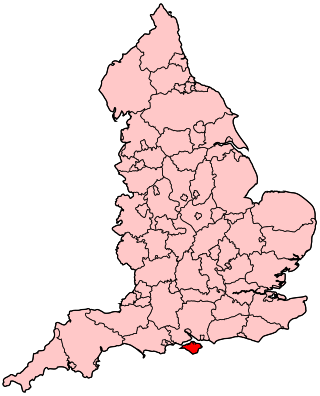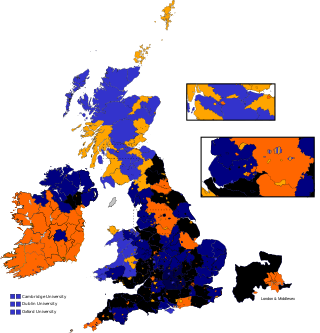History
The constituency consisted of the historic county of Hampshire, including the Isle of Wight. (Although Hampshire contained a number of parliamentary boroughs, each of which elected two MPs in its own right, these were not excluded from the county constituency, and owning property within the borough could confer a vote at the county election. This was even the case for the town of Southampton; although Southampton had the status of a county in itself after 1447, unlike most cities and towns with similar status its freeholders were not barred from voting at county elections.)
As in other county constituencies, the franchise between 1430 and 1832 was defined by the Forty Shilling Freeholder Act, which gave the right to vote to every man who possessed freehold property within the county valued at £2 or more per year for the purposes of land tax; it was not necessary for the freeholder to occupy his land, nor even in later years to be resident in the county at all. In the 18th century, the electorate amounted to around 5,000 voters.
Uniquely for a county constituency before the Reform Act, elections in Hampshire were held at two polling places, the poll being first opened at Winchester and then, once all the mainland voters had been polled, adjourning to Newport for the convenience of the Isle of Wight voters. This concession, however, only slightly mitigated the difficulties caused by voters having to travel to the county town to exercise their franchise.
IX. Poll for Knights of Shire for County of Southampton; adjourned from Winchester to Newport.
Provided alsoe and be itt enacted by the Authority aforesaid That the Sheriffe of the County of Southampton or his Deputy att the Request of one or more of the Candidates for Election of a Knight or Knights for that County shall adjourne the Poll from Winchester after every Freeholder then and there present is polled to Newport in the Isle of Wight for the ease of the Inhabitants of the said Island Any thing in this Act contained to the contrary notwithstanding.
— Parliamentary Elections Act 1695
| Parliament Act 1780 | |
|---|---|
| Act of Parliament | |
 | |
| Long title | An Act for holding the ensuing Election of a Knight of the Shire for the County of Southampton, at the Town of New Alresford, in the said County. |
| Citation | 20 Geo. 3. c. 1 |
| Dates | |
| Royal assent | 7 December 1779 |
| Commencement | 25 November 1779 [a] |
| Repealed | 21 August 1871 |
| Other legislation | |
| Repealed by | Statute Law Revision Act 1871 |
Status: Repealed | |
| Text of statute as originally enacted | |
| Parliament (No. 2) Act 1780 | |
|---|---|
| Act of Parliament | |
 | |
| Long title | An Act for exempting the City of Winchester, the County of Southampton, the Town of Shrewsbury, and the County of Salop, out of the Provisions of an Act, made in the Eighth Year of the Reign of His late Majesty King George the Second, intituled, "An Act for regulating the Quartering of Soldiers during the Time of the Elections of Members to serve in Parliament," so far as the same relates to the Removal of Troops during the Elections of Members to serve in Parliament, for a limited Time. |
| Citation | 20 Geo. 3. c. 50 |
| Dates | |
| Royal assent | 23 June 1780 |
| Commencement | 25 November 1779 [a] |
| Expired | 18 July 1781 [b] |
| Repealed | 21 August 1871 |
| Other legislation | |
| Amended by |
|
| Repealed by | Statute Law Revision Act 1871 |
Status: Repealed | |
| Text of statute as originally enacted | |
| Parliament Act 1781 | |
|---|---|
| Act of Parliament | |
 | |
| Citation | 21 Geo. 3. c. 43 |
| Dates | |
| Commencement | 31 October 1780 [a] |
| Expired | 11 July 1782 [b] |
| Repealed | 21 August 1871 |
| Other legislation | |
| Amends | Parliament (No. 2) Act 1780 |
| Repealed by | Statute Law Revision Act 1871 |
Status: Repealed | |
| Text of statute as originally enacted | |
| Parliament (No. 1) Act 1782 | |
|---|---|
| Act of Parliament | |
 | |
| Long title | An Act for further continuing an Act made in the Twentieth Year of the Reign of His present Majesty, intituled, "An Act for exempting the City of Winchester, the County of Southampton, the Town of Shrewsbury, and the County of Salop, out of the Provisions of an Act made in the Eighth Year of the Reign of His late Majesty King George the Second, intituled, 'An Act for regulating the Quartering of Soldiers during the Time of the Elections of Members to serve in Parliament;' so far as the same relates to the Removal of Troops during the Elections of Members to serve in Parliament for a limited Time." |
| Citation | 22 Geo. 3. c. 29 |
| Dates | |
| Royal assent | 17 May 1782 |
| Commencement | 27 November 1781 [a] |
| Expired | 20 May 1784 [c] |
| Repealed | 21 August 1871 |
| Other legislation | |
| Amends | Parliament (No. 2) Act 1780 |
| Repealed by | Statute Law Revision Act 1871 |
Status: Repealed | |
| Text of statute as originally enacted | |
During the American Revolutionary War, elections from 1779 to the 1783 Peace of Paris were in New Alresford instead of Winchester, because the existing law, the Parliamentary Elections Act 1734, (8 Geo. 2. c. 30) [1] would have required soldiers stationed at Winchester to depart during the election, leaving French and Spanish prisoners of war unguarded, [2] and the Parliamentary Elections Act 1695 (7 & 8 Will. 3. c. 25) required the sheriff to hold county elections "att the most publick and usuall Place of Election within the said County". The 1779 election was moved with the consent of the candidates. [3] Subsequently, the law was changed to require such a move, first by the Parliament Act 1780 (20 Geo. 3. c. 1), which applied to the December 1779 by-election; [4] then in preparation for the 1780 general election by section 2 of the Parliament (No. 2) Act 1780 (20 Geo. 3. c. 50), [5] which was continued by the Parliament Act 1781 (21 Geo. 3. c. 43) [6] and by the Parliament (No. 1) Act 1782 (22 Geo. 3. c. 29). [7] [2]
Up to Elizabethan times, at least, the voters had to contend with these difficulties themselves: Neale quotes an allusion to Hampshire freeholders "fasting and far from home" at a by-election in 1566 as evidence that the practice of feeding the voters to encourage their attendance was not yet universal. But later it became normal for voters to expect the candidates for whom they voted to meet their expenses in travelling to the poll and to entertain them generously when they reached it, making the cost of a contested election almost prohibitive in a county as large as Hampshire. When the prime minister Lord North sent £2,000 of the King's money to assist the government candidates fighting an election in Hampshire in 1779, he wrote to the King that it "bore ... a very small part of the expense" – yet it was insufficient to win the election, one of the government candidates being defeated.
Contested elections were therefore generally rare, potential candidates preferring to canvass support beforehand and usually not insisting on a vote being taken unless they were confident of winning; although there was a contest at each of the four general elections from 1705 to 1713, at all but four of the remaining 23 general elections before 1832, Hampshire's two MPs were elected unopposed.
Hampshire elections may have been less corrupt than most, and the 19th century chronicler of electoral abuses in the Unreformed Parliament, Thomas Oldfield, notes of the constituency that "We do not find a single petition [since 1640] complaining of an undue election in this county!!!" – complete with three exclamation marks. In the 18th and early 19th century Hampshire's voters were consistently of a High Tory persuasion, and throughout the 18th century the county's MPs were almost invariably nominees of the Crown. This influence arose in particular because of the number of government employees (in the dockyards at Portsmouth and Gosport, the forts of the Isle of Wight, and customs-houses all along the coast), as well as the Crown's tenants in the New Forest. Hampshire sentiments seem nevertheless to have been strongly in favour of reforming the House of Commons (views, no doubt, fuelled by the presence of several notorious rotten boroughs in the county), and on several occasions it submitted substantial petitions to Parliament in favour of the Reform Bill or of earlier unsuccessful proposals along the same lines.
According to the census of 1831, at around the time of the Great Reform Act Hampshire had a population of approximately 315,000. From 1832 the Reform Act split the constituency into three, giving the Isle of Wight a single member of its own and dividing the remainder of the county into two two-member divisions, Northern Hampshire and Southern Hampshire. (There were also minor changes to the parliamentary boundary between Hampshire and Sussex.)



